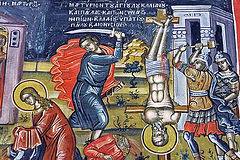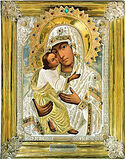

| Previous day | Next day |
| Old Style
June 3
|
Sunday |
New Style
June 16
|
| 7th Sunday of Pascha. Sunday of the Holy Fathers of the First Ecumenical Council. Tone 6. | No fast.
|
![]() Martyrs Lucillian and those with him at Byzantium: four youths—Claudius, Hypatius, Paul, and Dionysius—and the virgin Paula (ca. 270-275).
Martyrs Lucillian and those with him at Byzantium: four youths—Claudius, Hypatius, Paul, and Dionysius—and the virgin Paula (ca. 270-275).
Hieromartyrs Lucian, bishop, Maxianus, priest, and Julian, deacon and Martyrs Marcellinus and Saturninus, at Beauvais (Gaul) (ca. 81-96). Translation of the relics of the martyred Crown Prince Demetrius from Uglich to Moscow (1606).
New Hieromartyr Cyprian (Nelidov), hieromonk, of Moscow (1934).
“Chelnsk” Icon of the Most Holy Theotokos.
St. Achilles, bishop of Alexandria (312). St. Hieria, widow, of Mesopotamia (312). Monk-martyr Barsabas, abbot, of Ishtar, and ten companions, in Persia (342). St. Clotilde (Chlotilda), queen of France (545). St. Kevin, hermit and abbot, of Glendalough (618). St. Athanasius the Wonderworker, hieromonk of Traiannou Monastery in Bithynia (ca. 933). New Hieromartyr Joseph, metropolitan of Thessalonica (1821).
Repose of Archimandrite Justin (Parvu) of Petru Voda Monastery (Romania) (2013).
Thoughts for Each Day of the Year
According to the Daily Church Readings from the Word of God
By St. Theophan the Recluse

Sunday of the Holy Fathers. [Acts 20:16–18, 28–36; John 17:1–13]
Arias began to deny the divinity of the Son of God and His oneness in essence with God the Father. The entire Church rose up against him; all believers, from all ends of the earth, unanimously confessed that the Lord Jesus Christ is the Only-Begotten Son of God, true God of true God; begotten, not made, of one essence with the Father. One would think that this unanimity was purely coincidental, but this faith was then tried by fire when the authorities and powerful of this world began to side with the Arians. Neither fire, nor sword, nor persecution could extinguish this faith, and it was immediately found everywhere among everyone, as soon as the pressure from external powers ceased. This means that it makes up the heart of the Church and the essence of her confession. Glory be to the Lord, Who preserves this faith within us! For, as long as it exists, we are still Christians, though we may not live as such. If it ceases to exist, Christianity will end.
Articles
 Hieromartyr Lucian the Bishop at Beauvais in FranceThe Hieromartyr Lucian lived in Rome, and his pagan name was Lucius. He was converted to Christ by the Apostle Peter, and was baptized. |
 Hieromartyr Maximian the Presbyter at Beauvais in FranceSaint Maximian the priest was one of the companions of Saint Lucian, and assisted him in proclaiming the Gospel in the West. |
 Martyr Julian the Deacon at Beauvais in FranceSaint Julian the deacon was one of the companions of Saint Lucian, and assisted him in proclaiming the Gospel in the West. |
 Martyr Marcellinus at Beauvais in FranceSaint Marcellinus was one of the companions of Saint Lucian, and assisted him in proclaiming the Gospel in the West. |
 Hieromartyr Saturninus at Beauvais in FranceSaint Saturninus was one of the companions of Saint Lucian, and assisted him in proclaiming the Gospel in the West. |
 Translation of the relics of slain Crown Prince Demetrius of MoscowThe Tsarevich Saint Demetrius, murdered on May 15, 1591, was glorified in the year 1606. |
 Venerable Kevin of Glendalough, WonderworkerDmitry LapaSt. Kevin is one of the greatest saints of Ireland and founder of the famous and important Glendalough Monastery. |



